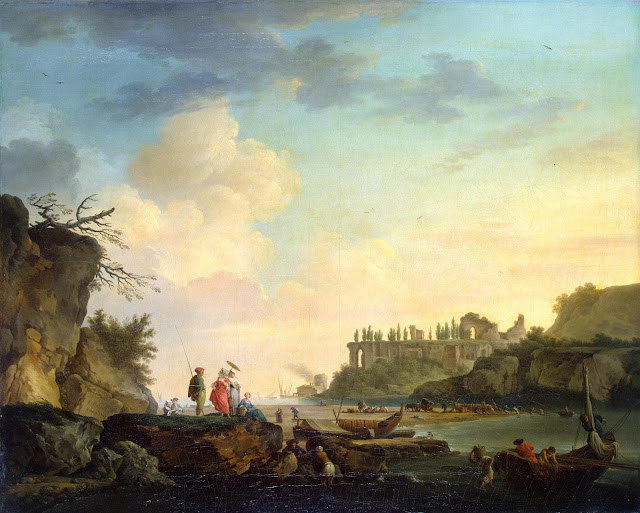 |
| Claude-Joseph Vernet Ruins near the mouth of a river 1748 oil on canvas Hermitage, Saint Petersburg |
"What do artists do to make their scenes seem convincing in the rhetorician's sense? What are the qualities in their version of reality that we find credible? A rhetorically versed observer is not going to regard a picture as 'possible' simply because he is convinced by its illusion of space, or because he is able to 'see' the dabs of colour as moving figures, clouds, ships, and so forth. He must also feel as though the events were taking place 'before his eyes', that they have been 'made actual', as though he were present and witnessing them himself. Looking at pictures with such an expectation set, we can identify various appeals to the spectator's understanding and his participation in their universe. The sense of presence, of being there ourselves, is more credible if the picture suggests a scene and actors rather than an outdoor space. Compositions built up round architectural settings and large figures (approaching natural size) provide the easiest way of creating an illusion of immediacy: the figures are analogous to the spectators who confront the picture from their own correspondingly constructed indoor space. But as soon as a painting has to depict events in the open, as soon as there has to be more natural light in the scene depicted, the illusion of spectator participation becomes more difficult to sustain. Landscape painting as a whole is thus difficult to bring into line with the demand for a sense of actual presence. Are there any indications that the landscape painters were trying to master this illusion? We know that landscape paintings are generally smaller than pictures in other genres, while the subjects they depict are large. The scale of the subject reduces the sense of presence; at the same time the small format of the picture itself means that before we can lose ourselves in it, we must distance ourselves from the real room in which we are. The old idea that the picture is a view seen through a window is of course relevant to landscape paintings, and the simile immediately implies the existence of two rooms. But in the ideal landscape the observer is invited to approach the natural scene as though he were there himself. The paintings thus present the observer with two barriers to be forced: in his imagination he must adjust the format to his own real-world scale, and he must somehow cope with the sense of outdoors that seems to preclude his own presence in the pictured world. Could it be that the illusion of immediate presence was not required of landscape painting? Perhaps the spectator was meant to feel as though he were gazing from far away – from a dream, a vision, a desire; that the 'seeing' itself was make-believe."
– from Ideal Landscape by Margaretha Rossholm Lagerlöf, translated from Swedish by Nancy Adler (Yale, 1990)
 |
| Claude-Joseph Vernet Landscape with Ruins - Grotto of the Nymph Egeria 1740s oil on canvas Hermitage, Saint Petersburg |
 |
| Hubert Robert Landscape with Triumphal Column 1773 oil on canvas Hermitage, Saint Petersburg |
 |
| Hubert Robert Cottage in the Forest 1796-97 oil on canvas Hermitage, Saint Petersburg |
 |
| Nicolas Lancret Concert in the Park before 1743 oil on canvas Hermitage, Saint Petersburg |
 |
| Nicolas Lancret Party in the Garden before 1743 oil on canvas Hermitage, Saint Petersburg |
 |
| Jean-Baptiste Pater Dance under Trees ca. 1725-35 oil on canvas Hermitage, Saint Petersburg |
 |
| Gabriel de Saint-Aubin Promenade ca. 1760-61 wash drawing Hermitage, Saint Petersburg |
 |
| Charles-Joseph Natoire Antony and Cleopatra ca. 1753-57 wash drawing Hermitage, Saint Petersburg |
 |
| Jean-Jacques de Boissieu House with Balcony before 1765 wash drawing Hermitage, Saint Petersburg |
 |
| Jean-Jacques de Boissieu Hut on a Riverbank 1763 wash drawing Hermitage, Saint Petersburg |
 |
| François Boucher Landscape near Beauvais 1740s oil on canvas Hermitage, Saint Petersburg |
 |
| François Boucher Crossing the Ford 1730s oil on canvas Hermitage, Saint Petersburg |
 |
| François Boucher Crossing the Bridge 1730s oil on canvas Hermitage, Saint Petersburg |